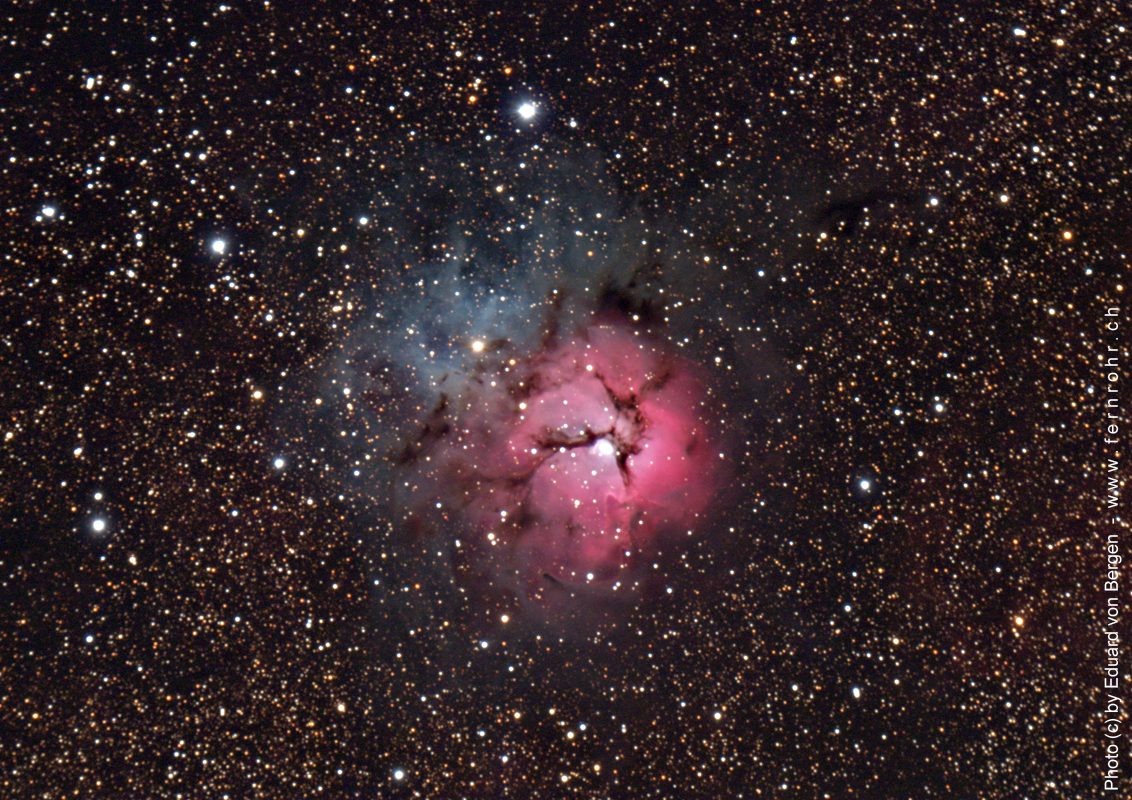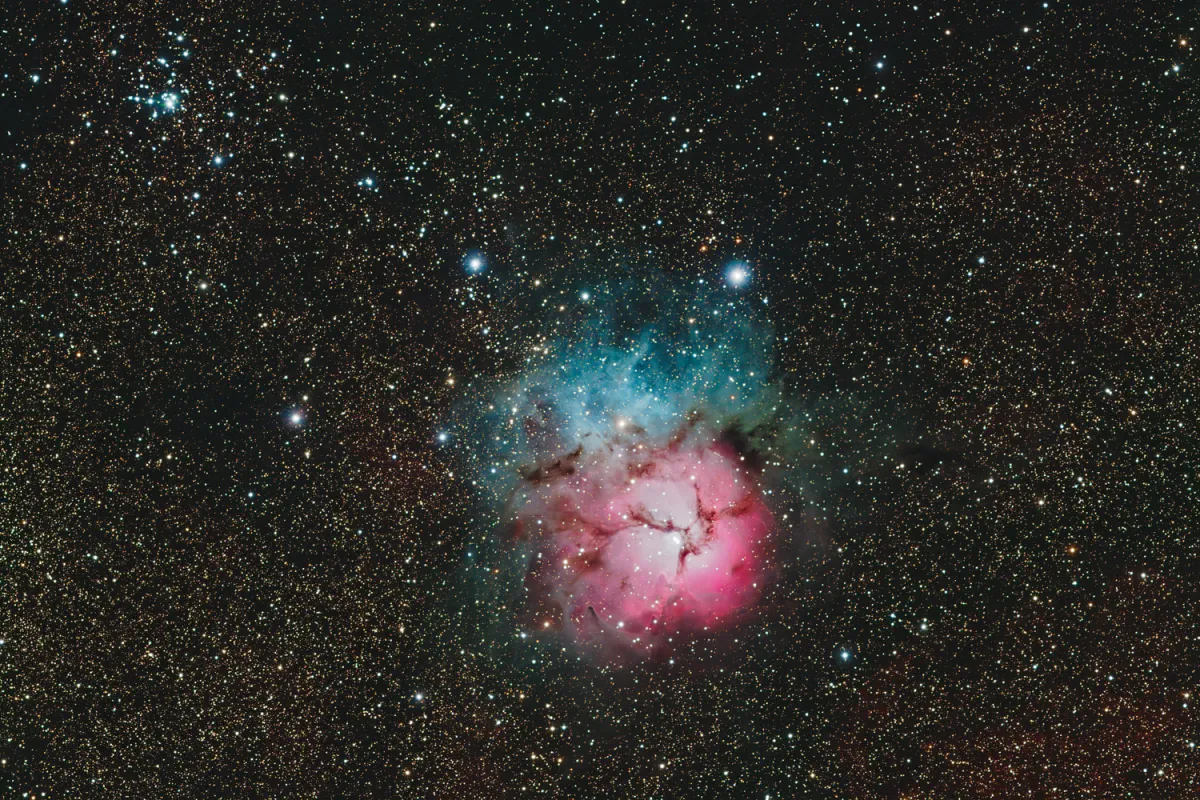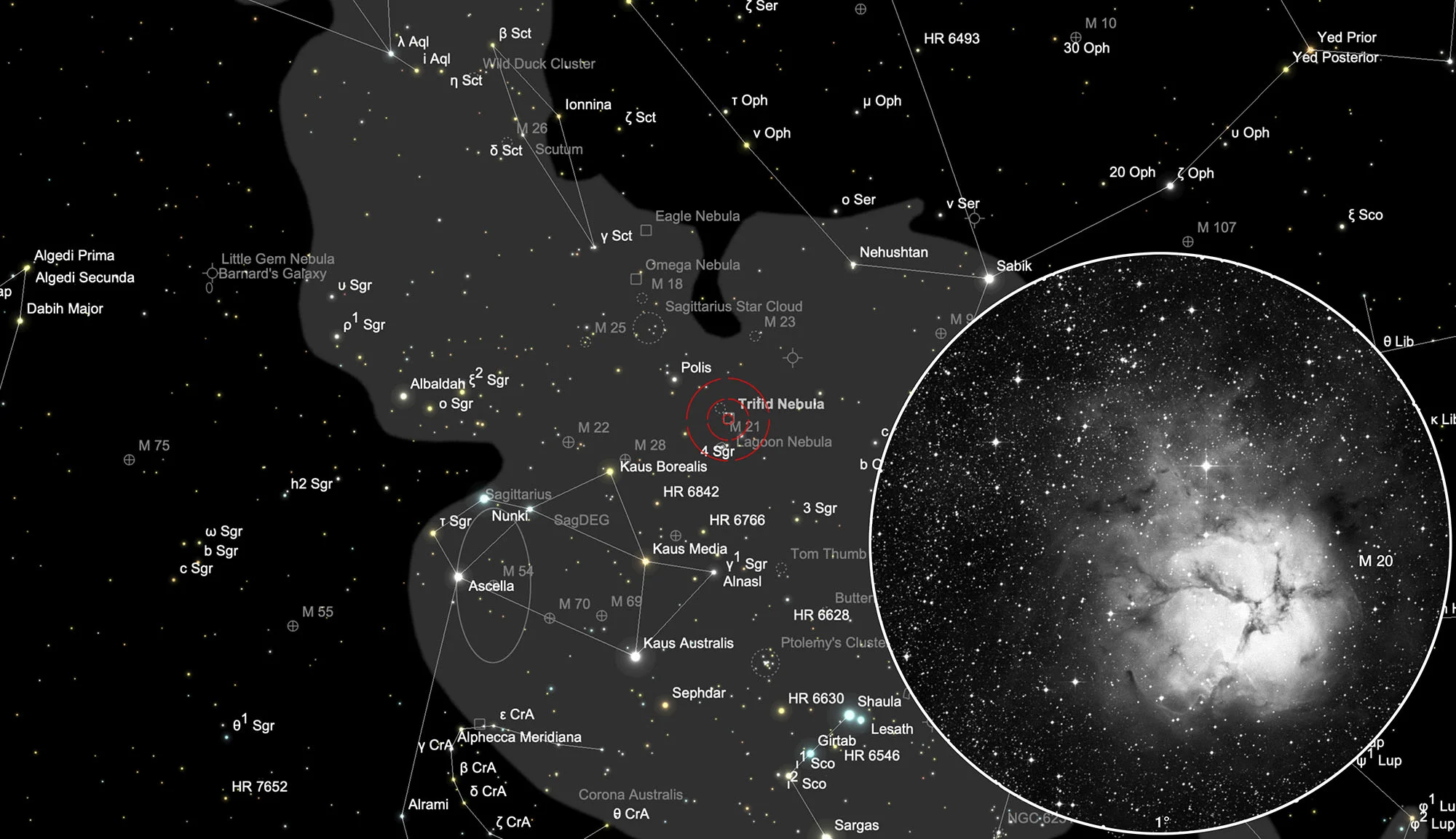Trifid Nebula (Messier 20)


History
M 20 was probably first spotted by LeGentil in 1747 while observing M 8 and later rediscovered by Charles Messier on 5 June 1764. Messier only saw the star cluster, because the light-gathering power of his telescopes was too low to be able to see the nebula. [4, 281]
Sir William Herschel observed the cluster on 12th July 1784 and cataloged three very large nebulae (V 10, V 11, V 12) and described them with: «Three nebula, faintly joined, form a triangle. In the middle is a double star. Very faint and of great extent.» [463] On 26 May 1785 he revisited the nebula and added with IV 41 another entry: «A double star with extensive nebulosity of different intensity. About the double star is a black opening resembling the nebula in Orion in miniature.» [464]
Herschels son John cataloged the object as h 1991 (= h 3718, GC 4355) and noted in his Slough catalogue of 1833: «Very large, trifid, three nebulae with a vacuity in the mindst, in which is centrally situated the double star SH 379, nebula = 7' in extent. A most remarkable object.» [466]
In the year 1919 Edward Barnard published his catalog of 182 «dark markings in the sky», identified on photographic plates made on the Lick Observatory. He showed that these markings are not just starless empty voids, but obscured by dark nebulae. the southern part of the Trifid Nebula is listed as number 85. [239]


Physical Properties
The Trifid Nebula combines the characteristics of an emission nebula and those of a reflection nebula. Excited hydrogen in the central region emits photons in the Balmer wavelength and therefore glows in a pink light. The outer region contains a lot of dust and reflects the light of the hot blue stars and forms the blue part of the Trifid Nebula. The bright star HD 164514 in the north is surrounded by a pronounced blue reflection nebula. The star is not hot enough to stimulate the surrounding gas to glow and so all light is reflected or scattered by the cold gas and dust.
The brightest area of the nebula measures around 20×15 arc minutes, but weaker outer regions allow the size of the nebula to grow to around 25 arc minutes. The «trifid pattern» can be found in the southern bright part of the nebula, where the three dark, approximately 45 arc seconds wide bands of dust lead out from the centre and stand out against the glowing background. The mass of the nebula is sufficient to form several thousand suns. The nebula is stimulated to glow by the strong ultraviolet radiation of hot, young stars.The multiple central star is designated HN 40 or GC 24537 and its age is estimated at around 7 million years.These are O7 stars with a calculated absolute Brightness of -5.2 mag. With the 36-inch refractor from the Lick Observatory, SW Burnham even found six stars in this system, whose brightness, distances and position angles are shown in the following table: [4]
Pair Magnitude Sep. PA A-B 7.0-10.6 5.4" 23° A-C - 8.8 10.6" 212° A-F -13.8 22.1" 106° C-D 8.8-10.5 2.2" 282° C-E -12.4 6.2" 191°
As with most galactic nebulae, the published distances are spread over a wide area. There are values from 2200 to 7700 light years. The latest values are around 5000 light years, which corresponds roughly to the distance from the Lagoon Nebula (M 8). The distance from M 20 is estimated to be about 1500 light years farther than that of M 8. The two nebulae are possibly of a gigantic H-II association, as Figure 3 suggests, but this association has not yet been proven. Like M 8, this nebula is also a source of strong radio and infrared radiation, which is typical for star formation areas. [4]
| Designation | NGC 6514 |
| Type | EN+OCL |
| Right Ascension (J2000.0) | 18h 02m 42.0s |
| Declination (J2000.0) | -22° 58' 18" |
| Diameter | 20 × 20 arcmin |
| Photographic (blue) magnitude | 8.5 mag |
| Metric Distance | 1.600 kpc |
| Dreyer Description | !!! vB, vL, trifid, D * inv |
| Identification, Remarks | WH V 10, V 11, V 12, IV 41; h 1991=3718; GC 4355; M 20; OCL 23; ESO 521-N*13; LBN 27; Trifid nebula |
Finder Chart
The Trifid Nebula is located in the constellation Sagittarius, about 1.5 ° north-northwest of the Lagoon Nebula. If you extend the axis from φ Sagitarii to λ Sagitarii and position the outer ring of the Telrad there, the trifid nebula should already be visible in a large field eyepiece. It can best be observed in the months of February to November. About 0.7 ° to the northeast is the small open star cluster M 21.
Visual Observation
762 mm Aperture: The dark bands of the Trifid Nebula's tripartition show up very nicely. Two nearby somewhat brighter stars give the eyes of a bat together with the surrounding nebula. Without filter the emission but especially the reflection part is more distinct than with OIII filter. Also without filter the plasticity of the whole nebula is better visible. With OIII filter the tripartition in the emission part is more structured. — 30" SlipStream-Dobson f/3.3, Hasliberg, 7. 8. 2015, Eduard von Bergen
